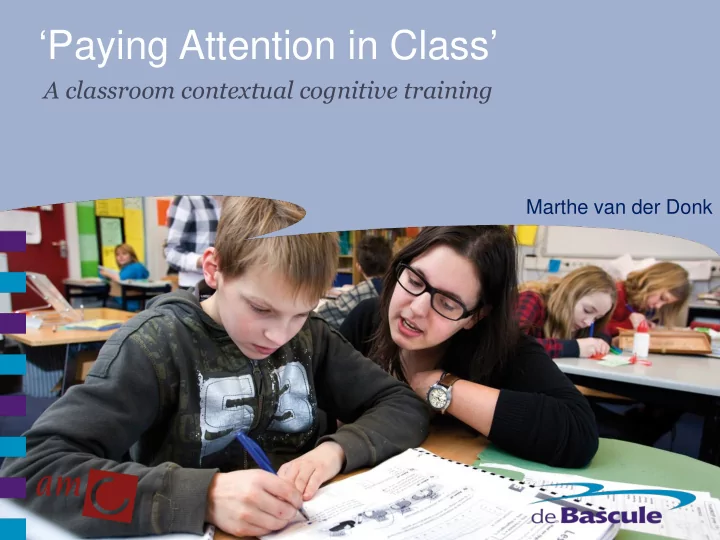

‘ Paying Attention in Class ’ A classroom contextual cognitive training Marthe van der Donk
Case of Daniel Problems that can be related to executive functions
Executive functions • Deficits often seen in children with ADHD (Barkley, 1997; Willcutt et al., 2005) • Important role in academic performance (Bull and Scerif, 2001) • Especially working memory skills (Aronen et al., 2005; Gathercole et al., 2000).
Cognitive training 1) Processed based interventions (Sonuga-Barke et al. 2014) 2) Compensatory interventions (Dehn, 2008) ▫ Strategy training (Morrison & Chein, 2011) ▫ Modify environment (e.g. Holmes, Gathercole & Dunning, 2010)
Previous studies of CWMT in children with ADHD Far transfer Near transfer
Critical notes 1) Theoretical concerns Near- and far transfer o 2) Methodological concerns Inconsistent methods o Lack of adequate control group o Single tasks o 3) Clinical implications
Aims of our study • Determine the effects of CWMT and compare effects with active control group • Extension with 6 months follow up and academic performance measures
Methods 102 children included • age 8-12 years Procedure • Diagnosed with ADHD Pre-assessment N=52 Cogmed Working N=50 Paying Attention in Memory Training Class Post assessment Follow-up 6 months
Methods Assessment Primary outcome measures • Neurocognitive functioning (attention, working memory, planning and inhibition) • Academic performance ( word reading fluency, automated math, spelling) • The Behaviour Rating of Executive Functions (BRIEF-P/T) Secondary outcome measures • Behavior in class (Learning Condition questionnaire) • Behavior problems (CBCL/TRF) • Quality of Life (Kidscreen-27)
Cogmed Working Memory Training - RM • Daily sessions • During school hours
Paying Attention in Class • 25 sessions of 45 minutes • Contextual to classroom learning • Three key ingredients Metacognition Goal directed behavior Working memory Planning and initation Selective attention
Paying Attention in Class Pitfalls (1) Psycho education Distraction Compensatory strategies Repeat Emotion Too fast Take Routine time Forgetful Picture
Paying Attention in Class (2) Working memory training Visual spatial span Listening recall span task My table Instruction task
Paying Attention in Class (3) Transfer to classroom • School related tasks • Registration card • Active involvement teacher
Demographics CWMT Paying Attention in Class (n=52) (n=50) Age 9.88 (1.33) 10 (1.31) boy/girl 34/15 36/13 Medication yes/no 20/25 18/29 ADHD-C/ADHD-I 55% / 43% 59% / 39% Learning Disability 22% 40% Type of education 89% / 4% / 7% 86% / 14% / 0% *** Regular/special primary/special education Linear Mixed Model & Bonferonni correction
Results – post treatment PAC CWMT Attention Attention Verbal WM Verbal WM d Visual WM Visual WM 0.87 Inhibition Inhibition Parents Parents • Behavior • Behavior regulation regulation • Metacognition • Metacognition • Attention • Attention Teacher Teacher • Attention • Attention
Results – follow up PAC CWMT Verbal WM Verbal WM d Visual WM Visual WM 0.49 Inhibition Inhibition Planning Planning Parents Parents • Attention • Attention Teacher Teacher • Attention • Attention • Metacognition • Metacognition
Summary & discussion 1) Broad improvements in neurocognitive functioning 2) Confirmed by both parent and teacher ratings 3) CWMT outperformed only on visual spatial working memory 4) Limitedness of far transfer
Future research (1) Why?
How and why? Working Trained function memory Non-trained function Attention
For whom? ADHD + WM problems
Thanks to: • Co authors and supervisors ▫ Anne-Claire Hiemstra, Ariane Tjeenk, Aryan van der Leij and Ramón Lindauer • Collaborators ▫ Marieke Krop, Carola Oosterveer, Jan Geelhoed, Jehanne Vieijra, Julie Stoter, Maartje van Ballegoij and Marjolijn Glotzbach • Funding ▫ Ministry of Education
Questions? • Marthe van der Donk m.vanderdonk@debascule.com
Recommend
More recommend